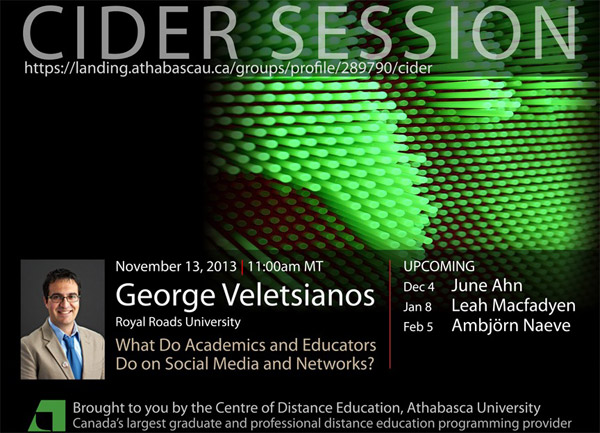We have a new paper available that continues our research on networked participation/learning and networked participatory scholarship. This one arises out of Royce Kimmons’ dissertation, which I had the joy, honor, and good fortune of chairing.
The media is filled with stories pertaining to educators’ and researchers’ participation in online social networks. For example, a debate erupted in Kansas in December 2013 regarding faculty members’ use of social media and teachers have found themselves in trouble for their social media updates. Yet, little research has been done to understand the relationship between educator identity and participation in Social Networking Sites (SNS) or to examine the implications that institutional regulation of such media may have upon educator identity.
In our latest research study, we developed a framework to understand how a group of teacher education students viewed their developing identities within social networking sites as they began the life transition to becoming educators. We found that educator identity consists of a constellation of interconnected acceptable identity fragments (AIF)*. These acceptable identity fragments are intentional, authentic, transitional, necessarily incomplete, and socially-constructed and socially-responsive.

Fragments by Maria McMahon. Unchanged. CC -BY 2.0 license.
We arrived at the term “acceptable identity fragment,” because study participants:
- shaped their participation in social networking sites in a manner that they believed to be “acceptable” to their audiences,
- viewed this participation to be a direct expression of “identity” or their sense of self, and
- felt this expression to only represent a small “fragment” of their complete identities.
The AIF suggests that participants in a given social context may limit their participation or expression of identity in a way that is appropriate to that specific context or is acceptable to the specific relationships they have with others in that context. The existence of the AIF means that educator identities within SNS are contextual and intentionally limited and structured. Participants believe that, when participating in SNS, they are expressing their identities in a limited, though authentic, manner. In their view, such expression represents a genuine fragment of their identities.
This view of educator identity contrasts sharply with previous views of identity by highlighting the complicated, negotiated, and recursive relationship that exists between educator participation in SNS and educator identity.
First, existing literature assumes that individuals have an authentic identity and suggests that they attempt to express these identities in varying degrees via social media. Our research finds that human beings may not ever find themselves in social contexts wherein they will choose to (or are even able to) express their full authentic identities and, instead, express a different AIF depending upon the situation.
Second, in Goffman’s view (1959), identity is adaptable and constantly emergent as we “act” in contexts. In the AIF view, there is no “acting” occurring, but rather we see a guarded revelation of fragments of the self. Thus, identity was not an emergent phenomenon of the scene; it was controlled and revealed partially.
Finally, Turkle (1995) suggests that the online self lacks coherence and is fluid. However, participants in our study were operating from what they believed to be a coherent sense of self and judged their SNS participation based upon alignment with that sense. Participation did not lack coherence – it was merely a partial manifestation.
What does this mean for educators, educational administrators, and educational researchers?
First, if the AIF is intentional and authentic, then it seems important for educators to retain control of their SNS participation. If institutions seek to prescribe appropriate and inappropriate uses of the medium, then it seems that this will prevent educators from being able to make meaningful choices regarding authentic self-expression and self-representation
Second, if the AIF is transitional, social media technologies must accommodate individuals’ transition into new life phases. At present, social media spaces do not support this (e.g., Facebook’s Timeline and the difficulty of deleting participation history en masse). If technologies doe not support the transition into new life phases, they risk being abandoned.
Third, educators should seek to recognize the assumptions that SNS platform developers are making about human nature, meaningful social participation, relationships, and so forth and consider the impact that such assumptions may have on their participation and identity.
Fourth, judgments made about educators based upon their participation in SNS should consider life transitions, time-based contexts (e.g., behavior as a college freshman vs. behavior as a student teacher), and the embedded values of the media.
Finally, if the AIF is a necessarily incomplete component of a larger identity constellation, any judgments of educators based on SNS participation must recognize that the relationship of the AIF to overall identity is subject to interpretation and may not reflect an individual’s perception of how the AIF represents authentic identity. Fragmentation of identity, then, should be seen as a valuable response to complex social situations. SNS platforms should account for this, and as we make judgments about others based upon their fragmented identities, we should be cognizant of the complex relationship existing between the AIF and one’s larger identity and dispel the myth of a simple authentic vs. inauthentic binary.
You can download a pre-print copy of the study from the link below:
Kimmons, R., & Veletsianos, G. (2014). The Fragmented Educator 2.0: Social Networking Sites. Acceptable Identity Fragments, and the Identity Constellation. Computers & Education, 72, 292-301. Journal link.
* The usual grounded theory and interpretive research caveats apply.



